2020 MASERATI GRANTURISMO CONVERTIBLE child restraint
[x] Cancel search: child restraintPage 59 of 296
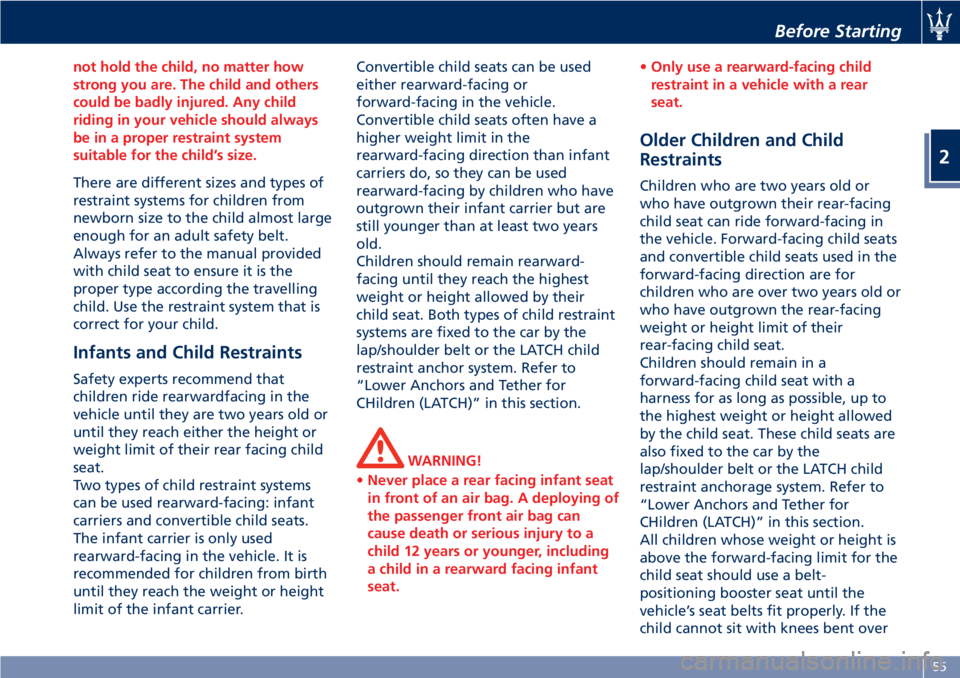
not hold the child, no matter how
strong you are. The child and others
could be badly injured. Any child
riding in your vehicle should always
be in a proper restraint system
suitable for the child’s size.
There are different sizes and types of
restraint systems for children from
newborn size to the child almost large
enough for an adult safety belt.
Always refer to the manual provided
with child seat to ensure it is the
proper type according the travelling
child. Use the restraint system that is
correct for your child.
Infants and Child Restraints
Safety experts recommend that
children ride rearwardfacing in the
vehicle until they are two years old or
until they reach either the height or
weight limit of their rear facing child
seat.
Two types of child restraint systems
can be used rearward-facing: infant
carriers and convertible child seats.
The infant carrier is only used
rearward-facing in the vehicle. It is
recommended for children from birth
until they reach the weight or height
limit of the infant carrier.Convertible child seats can be used
either rearward-facing or
forward-facing in the vehicle.
Convertible child seats often have a
higher weight limit in the
rearward-facing direction than infant
carriers do, so they can be used
rearward-facing by children who have
outgrown their infant carrier but are
still younger than at least two years
old.
Children should remain rearward-
facing until they reach the highest
weight or height allowed by their
child seat. Both types of child restraint
systems are fixed to the car by the
lap/shoulder belt or the LATCH child
restraint anchor system. Refer to
“Lower Anchors and Tether for
CHildren (LATCH)” in this section.
WARNING!
•Never place a rear facing infant seat
in front of an air bag. A deploying of
the passenger front air bag can
cause death or serious injury to a
child 12 years or younger, including
a child in a rearward facing infant
seat.•Only use a rearward-facing child
restraint in a vehicle with a rear
seat.
Older Children and Child
Restraints
Children who are two years old or
who have outgrown their rear-facing
child seat can ride forward-facing in
the vehicle. Forward-facing child seats
and convertible child seats used in the
forward-facing direction are for
children who are over two years old or
who have outgrown the rear-facing
weight or height limit of their
rear-facing child seat.
Children should remain in a
forward-facing child seat with a
harness for as long as possible, up to
the highest weight or height allowed
by the child seat. These child seats are
also fixed to the car by the
lap/shoulder belt or the LATCH child
restraint anchorage system. Refer to
“Lower Anchors and Tether for
CHildren (LATCH)” in this section.
All children whose weight or height is
above the forward-facing limit for the
child seat should use a belt-
positioning booster seat until the
vehicle’s seat belts fit properly. If the
child cannot sit with knees bent over
Before Starting
2
55
Page 60 of 296
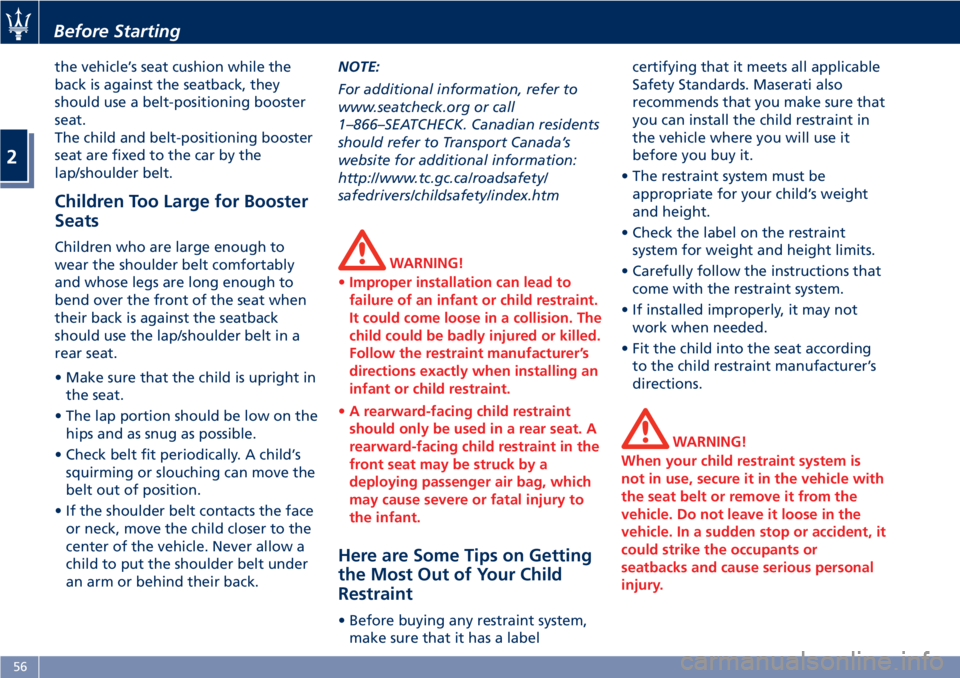
the vehicle’s seat cushion while the
back is against the seatback, they
should use a belt-positioning booster
seat.
The child and belt-positioning booster
seat are fixed to the car by the
lap/shoulder belt.
Children Too Large for Booster
Seats
Children who are large enough to
wear the shoulder belt comfortably
and whose legs are long enough to
bend over the front of the seat when
their back is against the seatback
should use the lap/shoulder belt in a
rear seat.
• Make sure that the child is upright in
the seat.
• The lap portion should be low on the
hips and as snug as possible.
• Check belt fit periodically. A child’s
squirming or slouching can move the
belt out of position.
• If the shoulder belt contacts the face
or neck, move the child closer to the
center of the vehicle. Never allow a
child to put the shoulder belt under
an arm or behind their back.NOTE:
For additional information, refer to
www.seatcheck.org or call
1–866–SEATCHECK. Canadian residents
should refer to Transport Canada’s
website for additional information:
http://www.tc.gc.ca/roadsafety/
safedrivers/childsafety/index.htmWARNING!
•Improper installation can lead to
failure of an infant or child restraint.
It could come loose in a collision. The
child could be badly injured or killed.
Follow the restraint manufacturer’s
directions exactly when installing an
infant or child restraint.
•A rearward-facing child restraint
should only be used in a rear seat. A
rearward-facing child restraint in the
front seat may be struck by a
deploying passenger air bag, which
may cause severe or fatal injury to
the infant.
Here are Some Tips on Getting
the Most Out of Your Child
Restraint
• Before buying any restraint system,
make sure that it has a labelcertifying that it meets all applicable
Safety Standards. Maserati also
recommends that you make sure that
you can install the child restraint in
the vehicle where you will use it
before you buy it.
• The restraint system must be
appropriate for your child’s weight
and height.
• Check the label on the restraint
system for weight and height limits.
• Carefully follow the instructions that
come with the restraint system.
• If installed improperly, it may not
work when needed.
• Fit the child into the seat according
to the child restraint manufacturer’s
directions.
WARNING!
When your child restraint system is
not in use, secure it in the vehicle with
the seat belt or remove it from the
vehicle. Do not leave it loose in the
vehicle. In a sudden stop or accident, it
could strike the occupants or
seatbacks and cause serious personal
injury.
Before Starting
2
56
Page 61 of 296
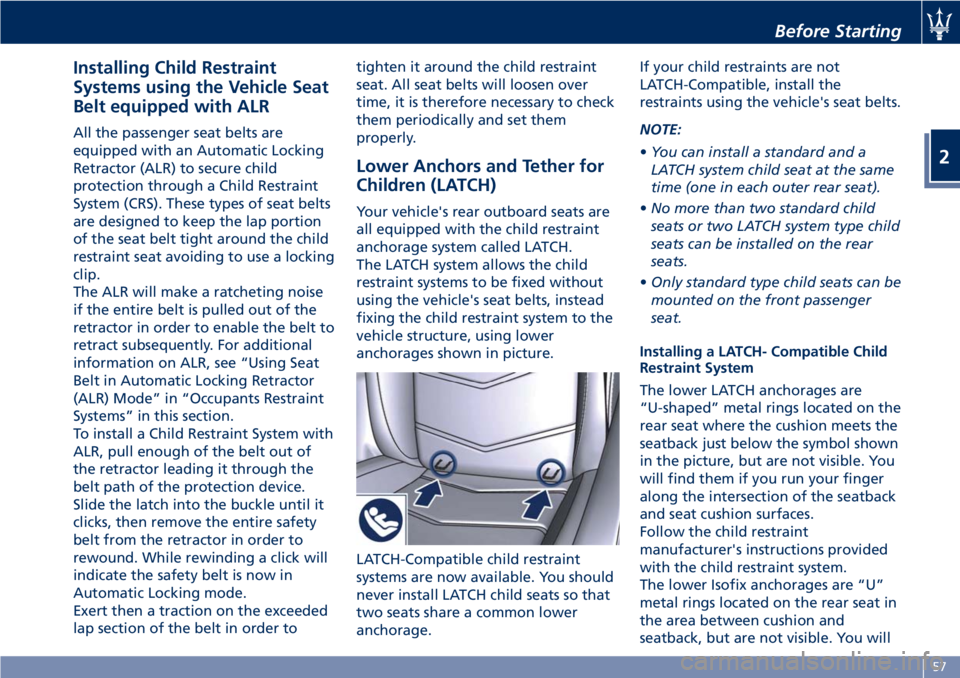
Installing Child Restraint
Systems using the Vehicle Seat
Belt equipped with ALR
All the passenger seat belts are
equipped with an Automatic Locking
Retractor (ALR) to secure child
protection through a Child Restraint
System (CRS). These types of seat belts
are designed to keep the lap portion
of the seat belt tight around the child
restraint seat avoiding to use a locking
clip.
The ALR will make a ratcheting noise
if the entire belt is pulled out of the
retractor in order to enable the belt to
retract subsequently. For additional
information on ALR, see “Using Seat
Belt in Automatic Locking Retractor
(ALR) Mode” in “Occupants Restraint
Systems” in this section.
To install a Child Restraint System with
ALR, pull enough of the belt out of
the retractor leading it through the
belt path of the protection device.
Slide the latch into the buckle until it
clicks, then remove the entire safety
belt from the retractor in order to
rewound. While rewinding a click will
indicate the safety belt is now in
Automatic Locking mode.
Exert then a traction on the exceeded
lap section of the belt in order totighten it around the child restraint
seat. All seat belts will loosen over
time, it is therefore necessary to check
them periodically and set them
properly.
Lower Anchors and Tether for
Children (LATCH)
Your vehicle's rear outboard seats are
all equipped with the child restraint
anchorage system called LATCH.
The LATCH system allows the child
restraint systems to be fixed without
using the vehicle's seat belts, instead
fixing the child restraint system to the
vehicle structure, using lower
anchorages shown in picture.
LATCH-Compatible child restraint
systems are now available. You should
never install LATCH child seats so that
two seats share a common lower
anchorage.If your child restraints are not
LATCH-Compatible, install the
restraints using the vehicle's seat belts.
NOTE:
•You can install a standard and a
LATCH system child seat at the same
time (one in each outer rear seat).
•No more than two standard child
seats or two LATCH system type child
seats can be installed on the rear
seats.
•Only standard type child seats can be
mounted on the front passenger
seat.
Installing a LATCH- Compatible Child
Restraint System
The lower LATCH anchorages are
“U-shaped” metal rings located on the
rear seat where the cushion meets the
seatback just below the symbol shown
in the picture, but are not visible. You
will find them if you run your finger
along the intersection of the seatback
and seat cushion surfaces.
Follow the child restraint
manufacturer's instructions provided
with the child restraint system.
The lower Isofix anchorages are “U”
metal rings located on the rear seat in
the area between cushion and
seatback, but are not visible. You will
Before Starting
2
57
Page 62 of 296
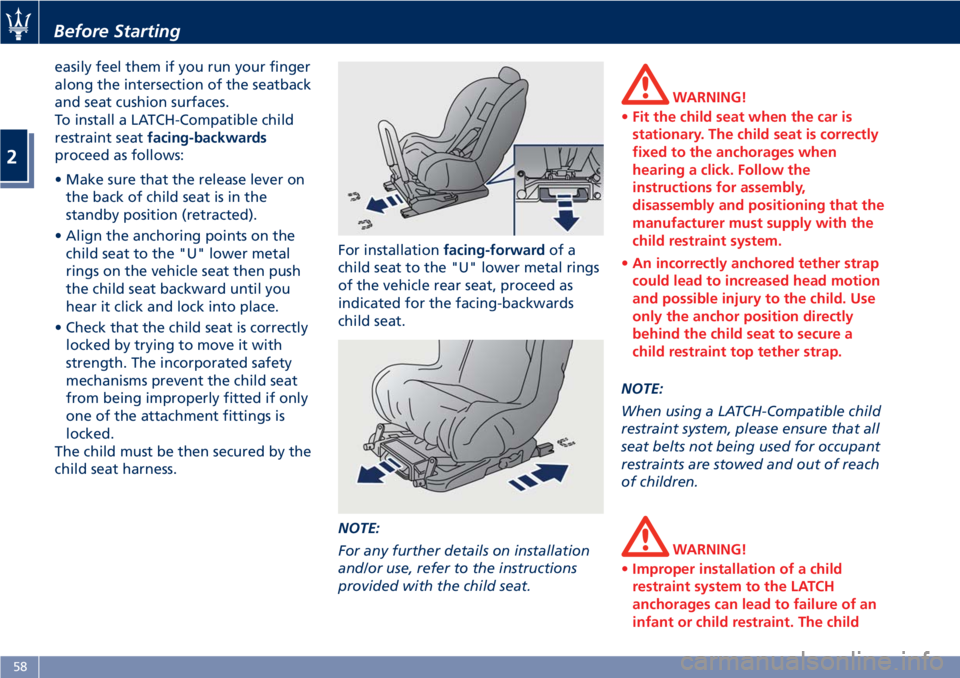
easily feel them if you run your finger
along the intersection of the seatback
and seat cushion surfaces.
To install a LATCH-Compatible child
restraint seatfacing-backwards
proceed as follows:
• Make sure that the release lever on
the back of child seat is in the
standby position (retracted).
• Align the anchoring points on the
child seat to the "U" lower metal
rings on the vehicle seat then push
the child seat backward until you
hear it click and lock into place.
• Check that the child seat is correctly
locked by trying to move it with
strength. The incorporated safety
mechanisms prevent the child seat
from being improperly fitted if only
one of the attachment fittings is
locked.
The child must be then secured by the
child seat harness.For installationfacing-forwardof a
child seat to the "U" lower metal rings
of the vehicle rear seat, proceed as
indicated for the facing-backwards
child seat.
NOTE:
For any further details on installation
and/or use, refer to the instructions
provided with the child seat.
WARNING!
•Fit the child seat when the car is
stationary. The child seat is correctly
fixed to the anchorages when
hearing a click. Follow the
instructions for assembly,
disassembly and positioning that the
manufacturer must supply with the
child restraint system.
•An incorrectly anchored tether strap
could lead to increased head motion
and possible injury to the child. Use
only the anchor position directly
behind the child seat to secure a
child restraint top tether strap.
NOTE:
When using a LATCH-Compatible child
restraint system, please ensure that all
seat belts not being used for occupant
restraints are stowed and out of reach
of children.
WARNING!
•Improper installation of a child
restraint system to the LATCH
anchorages can lead to failure of an
infant or child restraint. The child
Before Starting
2
58
Page 63 of 296
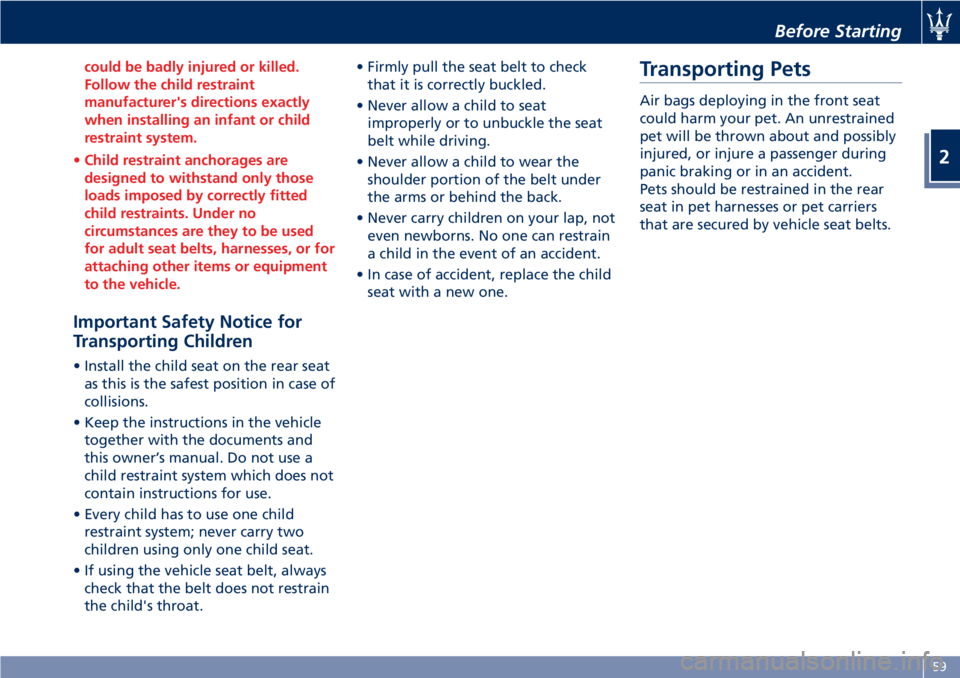
could be badly injured or killed.
Follow the child restraint
manufacturer's directions exactly
when installing an infant or child
restraint system.
•Child restraint anchorages are
designed to withstand only those
loads imposed by correctly fitted
child restraints. Under no
circumstances are they to be used
for adult seat belts, harnesses, or for
attaching other items or equipment
to the vehicle.
Important Safety Notice for
Transporting Children
• Install the child seat on the rear seat
as this is the safest position in case of
collisions.
• Keep the instructions in the vehicle
together with the documents and
this owner’s manual. Do not use a
child restraint system which does not
contain instructions for use.
• Every child has to use one child
restraint system; never carry two
children using only one child seat.
• If using the vehicle seat belt, always
check that the belt does not restrain
the child's throat.• Firmly pull the seat belt to check
that it is correctly buckled.
• Never allow a child to seat
improperly or to unbuckle the seat
belt while driving.
• Never allow a child to wear the
shoulder portion of the belt under
the arms or behind the back.
• Never carry children on your lap, not
even newborns. No one can restrain
a child in the event of an accident.
• In case of accident, replace the child
seat with a new one.
Transporting Pets
Air bags deploying in the front seat
could harm your pet. An unrestrained
pet will be thrown about and possibly
injured, or injure a passenger during
panic braking or in an accident.
Pets should be restrained in the rear
seat in pet harnesses or pet carriers
that are secured by vehicle seat belts.
Before Starting
2
59
Page 290 of 296

Abbreviations.................7
ABS (Anti-lock Braking System) . . .179
A/C Air Filter Replacement.......263
Accessories
Aftermarket Parts and Accessories
Statement.................11
Accident, in the event of........213
A/C System Maintenance........262
Airbag.....................46
Air bag System Components.....46
Air bag Warning Light.........66
Passenger Air bag Labels.......18
Supplemental Restraint System
(SRS).....................46
Air Conditioning Controls.......151
Air Conditioning Distribution.....112
Alarm, Vehicle Security..........26
ALR (Automatic Locking Retractor) . .43
Assistance....................9
Assistance, if you need.........9
Audio Controls...............138
Steering Wheel Audio Controls . .138
Audio, Customer Setting........147
Audio System................140
Automatic Transmission........160
Automatic Transmission Range . .162
AUX, USB and SD Memory Card
Ports.....................132
Battery....................247
Access the Battery...........226
Jump Start Procedure........226
Maintenance - Free Battery. . . .247To Reconnect the Battery......248
Bluetooth, Customer settings.....147
Bodywork Maintenance and Care . .265
Protection from Atmospheric
Agents..................265
Useful Advice to Keep the
Bodywork in Good Condition . . .265
Brakes
Brake and Stability Control
System...................177
Brake Fluid Level Check.......242
Brake Overheating..........182
Parking Brake..............174
Parking Brake - Manual
Release..................220
Using the Brakes............181
Bulb Replacement............257
Cargo Area.................107
Child Restraint Systems
Children too large for Booster
Seats.....................56
Infants and Child Restraints.....55
Lower Anchors and Tether for
Children (LATCH)............57
Older Children and Child
Restraints.................55
Tips on getting the most out of
your child restraint...........56
Clock, analog................144
Comfort Pack Front Seats........76
Driver Memory Seat..........77
Front Heated Seats...........76Console
Central Console Components....73
Front Dome Console
Components...............71
Cruise Control...............185
Cupholders
Front Seats Cupholders.......103
Rear Seats Cupholders........104
Dashboard Components.........70
Data, Technical..............279
Defroster...................66
Doors Components.............72
Drive Mode, Controls..........169
Driving Conditions
Before the Trip.............204
Driving at Night............204
Driving in Fog..............205
Driving in the Mountains......205
Driving in the Rain..........204
Driving on Snow or Ice........206
Driving through Flooded
Sections..................206
Safe Driving...............204
DRL (Daytime Running Light)......83
Easy Entry/Exit function.........79
EDR (Event Data Recorder).......52
Emergency
Emergency Fuel Filler Door
Release..................203
Hazard Warning Flasher.......88
In the Event of an Accident. . . .213
Index
9
286
Page 291 of 296

Jump Starting Procedure......225
ToolKit..................212
Towing a Disabled Vehicle.....228
Engine
Engine Air Filter Replacement . .245
Engine Coolant Level Check. . . .240
Engine Oil Level Check.......243
Engine Overheating.........214
Engine Start Failure.........159
Engine Turn Off............159
Hood, Open and Close........37
Normal Starting of the Engine . .158
Use of the Engine...........183
EPB (Electric Parking Brake)......174
ESC (Electronic Stability Control) . .177
Filters
A/C Air Filter Replacement.....263
Engine Air Filter Replacement . .245
Fuel
Carbon Monoxide Warning. . . .201
Emergency Fuel Filler Door
Release..................203
Fuel Consumption Data.......278
Fuel Requirements..........199
Fuel System Warnings........201
Gasoline/Oxygenate Blends. . . .200
Materials Added to Fuel......201
MMT in Gasoline...........200
Reformulated Gasoline.......200
Fuses Position and Replacement. . .251
HomeLink..................108Hood, Open and Close..........37
Indicator Lights
Air bag Warning Light........66
Indicator Lights/Warning Lights
TFT Display: Warning/Indicator
Lights...................126
Warning and Indicator Lights on
Analog Instrument..........119
Inertia Switch, Fuel Cut-out......229
Infotainment System..........130
Manual Controls and Devices . .132
Installing a LATCH-Compatible
Child Restraint System.........57
Instrument Cluster............118
Interior Components...........70
Interior Maintenance and Cure . . .268
Interiors Features.............102
Jump Start Procedure.........
.226
Keys
......................22
Level Checks................240
Adding Windshield/Headlight
Washer..................243
Brake Fluid Level Check.......242
Engine Coolant Level Check. . . .240
Engine Oil Level Check.......240
Power Steering Fluid Level
Check...................245
Transmission Oil Check.......245
Lights.....................82Adaptive Bi-Xenon Headlights . . .84
Automatic Headlights.........84
Bulb Replacement..........257
Cargo Light................88
DRL, Daytime Running Lights....83
Front Domelights............87
Hazard Warning Flasher.......88
Headlights................84
High Beams and Flashing......86
Light Switch...............82
Parking Lights..............84
Rear Fog Lights.............85
Turn Signals................86
Twilight Sensor.............85
Loading the Vehicle
Vehicle Load Carrying Capacity . .107
Maintenance
A/C System Maintenance......262
Bodywork Maintenance and
Care....................265
Interior Maintenance and Care . .268
Maintenance Procedures......239
Periodic Maintenance........237
Scheduled Maintenance
Service..................232
Scheduled Service Plan.......234
Wheels Maintenance........263
Maserati Roadside Assistance
Program...................15
MIL (Malfunction Indicator Light). .119
Mirrors
Folding Mirrors.............81
Index
9
287
Page 292 of 296

Inside Rearview Mirror........81
Mirrors Positioning...........80
Outside Mirrors.............80
MTC+ “Controls” Screen........141
MTC+ Settings - Customer
Programmable Features.......141
MTC+ System (Maserati Touch
Control Plus), Controls........138
Onboard Computer (Trip).......167
Onboard Diagnostics System.....183
ORC
(Occupant Restraint Controller) . . .50
Park Assist...................60
Parking....................176
Parking Brake...............174
Emergency Release of Parking
Brake...................220
Parking (Camera)..............63
Part Service..................11
Pets, transporting.............59
Phone/Bluetooth
Phone and Voice Controls on
Steering Wheel.............155
Phone/Bluetooth, Customer
settings..................147
Phone Mode..............156
Voice Commands...........156
Pollution Control Devices.......207
Power Outlets...............102
Refillings...................276Refueling..................202
Reporting Safety Defects.........10
Restraint System
Child Restraint Systems........54
Occupant Restraint System......38
Roadside Assistance Program......15
Safety
Child Restraint Systems........54
Occupant Restraint System......38
Safety Tips.................65
Supplemental Restraint System -
Air bags..................46
Scheduled Maintenance Service . . .232
Scheduled Service Plan.........234
SD Memory Card, USB and AUX
Ports.....................132
Seat Belt
Load Limiting Devices.........44
Loking Retractor (ALR) Mode....43
Rear Passenger Seat Belts.......42
Seat Belt Reminder Light
.....
.121
Seat Belt Reminder System (SBR) . .45
Seat Belts and Pregnant Women . .45
Seat Belts Pretensioners........44
Three-Point Seat Belts.........40
Three-Point Seat Belts Untwisting
Procedure.................42
Seats, Front..................74
Front Seats Cupholders.......103
Power Lumbar..............75
Seat Adjustment.............74
Seatback Tilt...............75Seats, Rear..................78
Rear Armrest...............79
Rear Head Restraints..........78
Rear Seats Cupholders........104
Service and Warranty............8
Siri Smart Personal Assistant.....156
Skyhook Suspension...........114
Smoking Kit.................106
Snow Chains................193
SRS (Supplemental Restraint System) -
Air Bags...................46
Start the Engine
Engine Start Failure..........159
Normal Starting of the Engine . .158
Steering Wheel Adjustment.......79
Phone and Voice Controls on
Steering Wheel.............155
Stored, Vehicle...............269
Stuck Vehicle, Freeing..........223
Symbols....................12
Tank, Fuel Refill..............202
Technical Data...............279
Telltales
Telltales on Speedometer......119
Telltales on Tachometer.......121
TFT Display: Warning/Indicator
Lights...................124
TFT Display
Controls..................124
Menus and Settings..........124
Screen Pages..............125
Tire Repair Kit...............214
Index
9
288